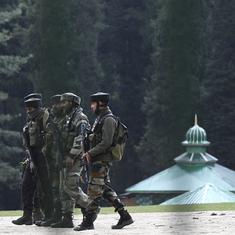In 1995, MF Husain was a charismatic 80 year old given to flamboyant gestures, who walked the city’s roads barefoot, whose paintings fetched astronomical prices, who was courted by socialites and honoured by governments. Within the art community there were whispers about his proximity to the rich negatively impacting his work, but even his critics acknowledged the central role he had played in developing a modernist style inflected by Indian attributes without being in the least parochial.
In the late 1960s, Ram Manohar Lohia had asked Husain why modern art did not enjoy a wide viewership, and the artist responded with his most innovative and quixotic project: a series of paintings based on episodes from the Ramayana, which he toured through villages on bullock carts. Soon after, he created a parallel suite of works on the Mahabharata and shipped these to Brazil, where he was slated to exhibit alongside Pablo Picasso as a special invitee to the Sao Paulo Biennale.
Deep knowledge
Husain was familiar with Hindu mythology from his childhood, having been born in the pilgrimage town of Pandharpur and watched Ram Lila performances frequently while growing up in Indore. However, he bolstered his knowledge through recitations by Pandits and extensive reading before embarking on his interpretation of the epics.
In all the decades he painted Hindu deities and legends before the 1990s, nobody suggested he was insulting the faith. Quite the contrary, he seemed the embodiment of India’s syncretic culture. His art, always celebratory in contrast with the despair, violence, and gloominess of much modernism, has always seemed to me to be imbued with the festive spirit of Hinduism. And yet, in his 81st year, Husain was targeted by right-wing Hindu groups for supposedly insulting their faith, a charge that was to hound him till the end of his life, leading ultimately to his leaving the country he cherished.
The first complaint against Husain related to a sketch he had made in the 1970s as part of a series on Indian goddesses. That this minor work should have been re-invoked in the mid 1990s, and publicised widely as an affront to Hinduism, demonstrates the dangerous power of false re-contexting.
Despite its slightness, Husain’s Saraswati is a good illustration of the way modern artists reinvent traditional icons: Its very simplicity makes it a fine exemplar. The figure is sketched in elegant, precise lines, less voluptuous than the conventional Indian representations.
Respectful work
The image’s most compelling feature is the flowing water near the top denoted by three wavy lines, which breaks the goddess’s arm at the wrist because of refraction, so the hand holding a lotus above the surface appears disconnected. Through this elementary device, Husain highlights the evolution of the divinity from her earliest form as the great river of the Rig Veda, to her eventual status as the goddess of music and knowledge. This sketch is, to my knowledge, the earliest image to conjoin these two aspects of Saraswati, and as such is a perfectly respectful and well-considered addition to an iconographic history rather than an attempt at insulting a faith.
For those who ask why Husain painted Hindu figures naked and not Muslim ones, the answer is simple: he aimed to work with traditions and reconfigure them, and there are no traditions of nude Islamic paintings the way there are of Hindu icons. For what it is worth, I support the right of an artist or cartoonist to depict in the nude revered figures from Islam’s history, but the intent of such an artist or cartoonist would be to shock, and while shock is a legitimate satirical and artistic mode, it was never Husain’s chosen one. He wanted, rather, to exalt India’s villages and cities, its many faiths and customs, its aspirations to modernity, its diversity and inclusiveness. That he of all people became a target of sectarian hatred is a poignant reminder of our failure to live up to the best of our traditions and merge them with a modern understanding of individual rights.
There is, however, one good thing that emerged from the harassment of our foremost artist: a judgement by Justice Sanjay Kishan Kaul in the Delhi High Court that is worth reading in full for its carefully argued defence of the freedom of artistic expression.










